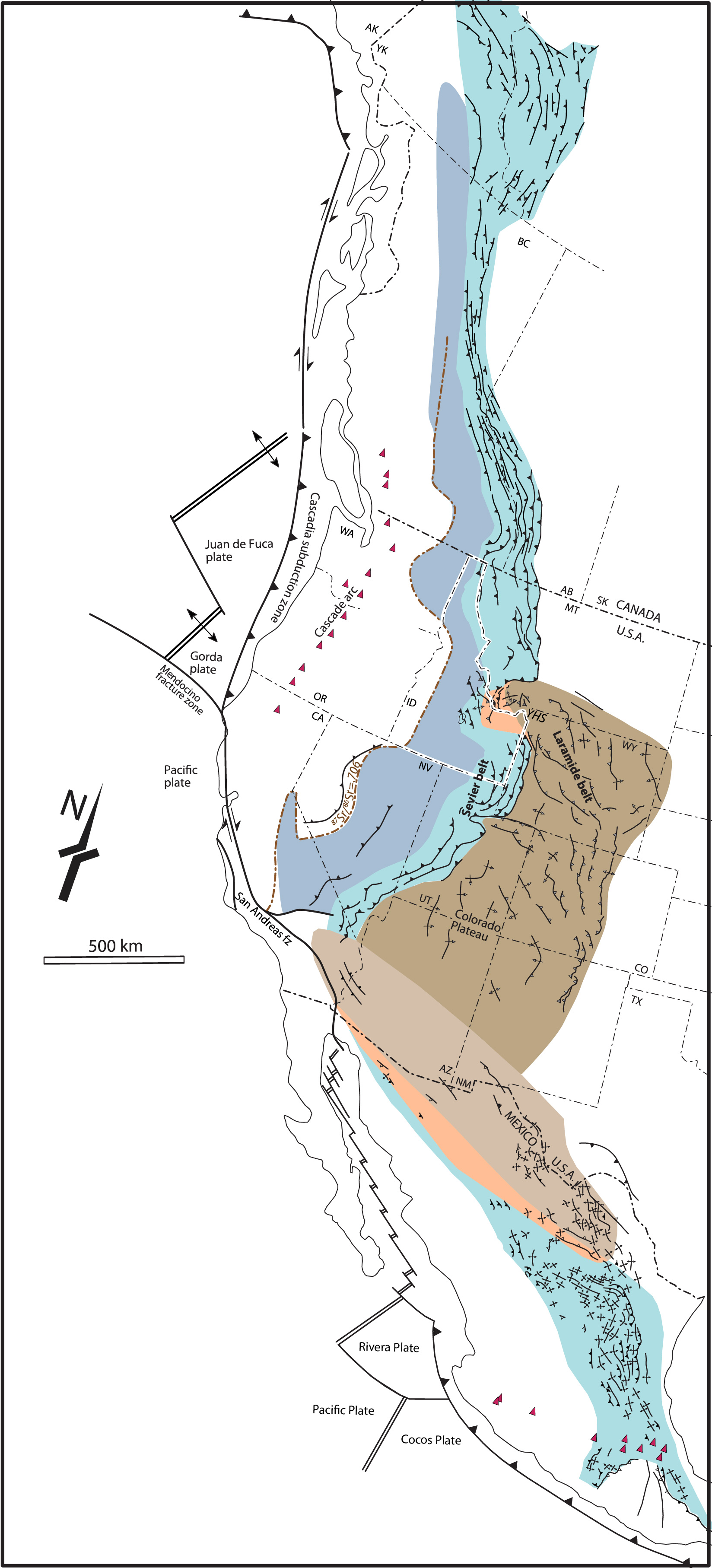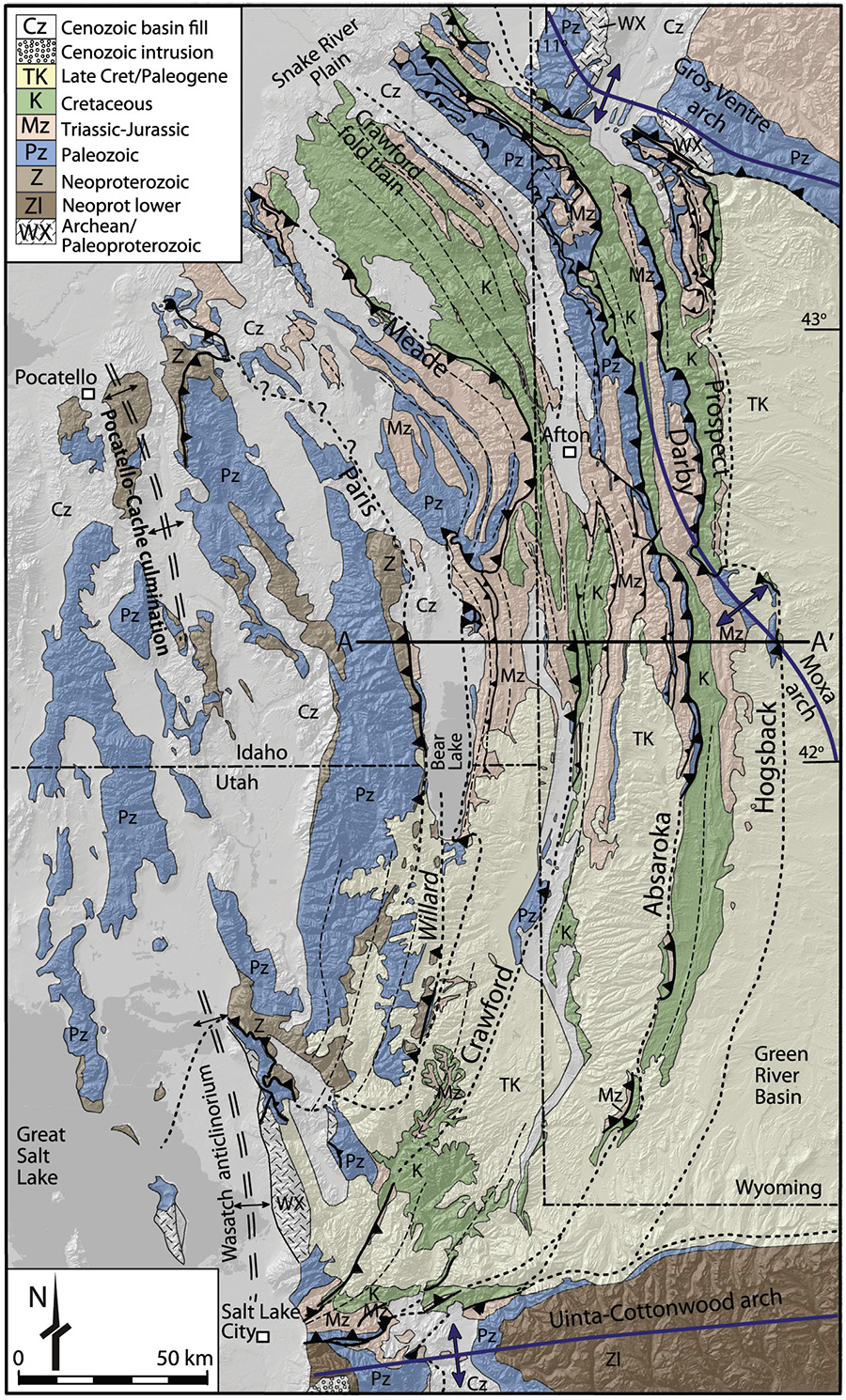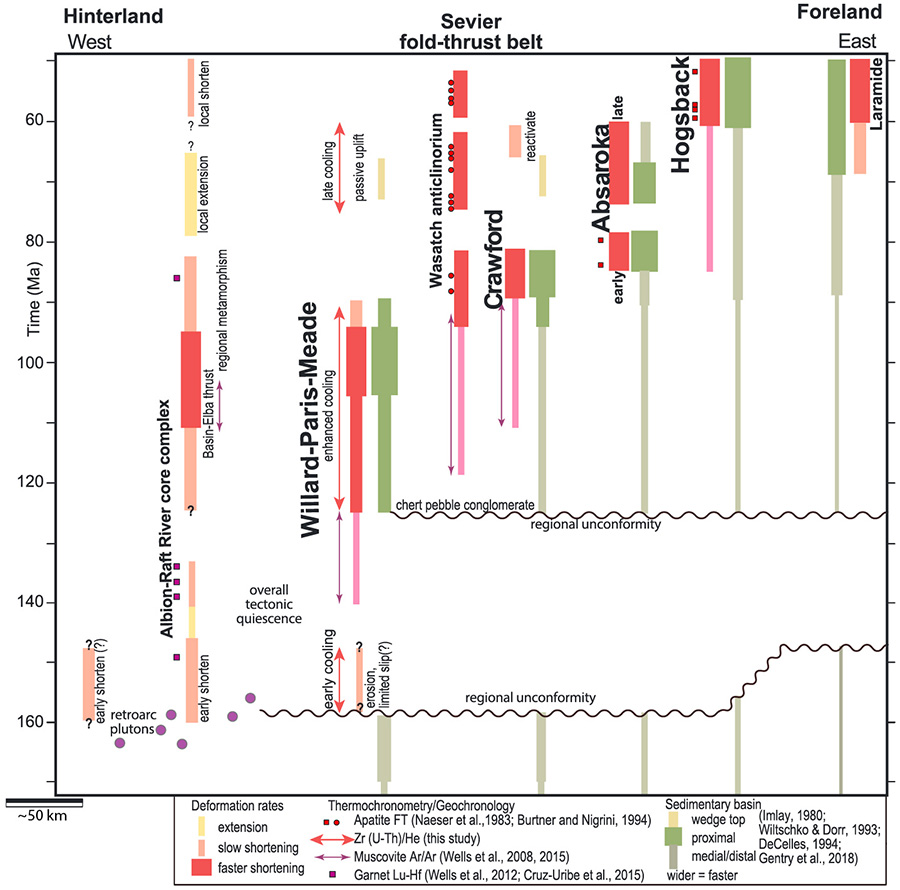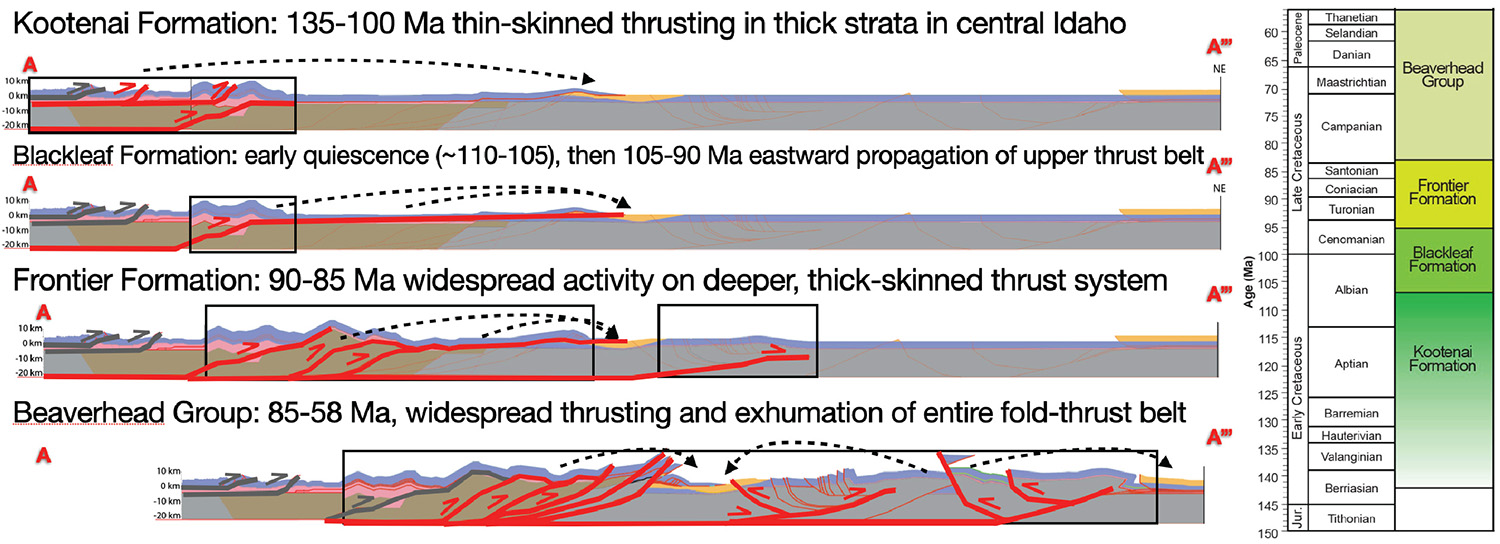Sevier-Laramide fold-thrust belt
The fold and thrust belt of the Cretaceous Sevier-Laramide orogenic belt spans nearly the entire length of North America, from Alaska to Mexico. It is a fundamental component of the North American Cordillera. The fold-thrust belt had a profound influence on the geology of Idaho and is exposed in southeastern Idaho, central and east-central Idaho, and in the Idaho panhandle.
PDF slideshows: Thrust belt overview, Sevier belt south of ESRP, Sevier belt north of ESRP.

(Above) Tectonic map of the North American Cordillera showing major tectonic features (modified from Yonkee and Weil, 2015 and Fitz Diaz et al., 2018).

(Above) Simplified tectonic map showing the "expanded" Sevier-Laramide fold-thrust belts in the context of the North American Cordillera (modified from Yonkee and Weil, 2015 and Fitz Diaz et al., 2018).
The Cordilleran orogenic belt formed during subduction of the Farallon plate beneath North America (Armstrong, 1968; Burchfiel and Davis, 1972, 1975; DeCelles, 2004) with associated intrusion of batholiths like the Idaho batholith, overthickening of crust east of the magmatic belt, and development of a thrust and fold belt within the Mesoproterozoic, Neoproterozoic, and Paleozoic strata to the east.

(Above) Schematic cross section across the ocean-continent subduction zone from outboard of California (left side of cross section), through Nevada and Utah (east side of cross section) (modified from Long, 2018).
The thrust faults within much of the Sevier belt are "thin-skinned", meaning they are not very deep, and that their geometry flattens at depth and follows layers of weakness along bedding planes in Paleozoic and Proterozoic strata. For the most part, these thrusts did not deform crystalline basement rocks of the Wyoming craton, unlike "thick-skinned" thrusts of the Laramide belt, which carried basement rocks with a very thin sedimentary cover.
Thin-skinned and thick-skinned structures in the Sevier-Laramide fold-thrust belt of the North American Cordillera are considered by many workers to occupy geographically separate regions, with limited spatial and temporal overlap between them. This has led to the hypothesis that thin-skinned, Sevier belt thrusts formed during a phase from ~160-70 Ma where the subducting Farallon plate was steeply dipping. In contrast, many workers consider the post-70 Ma transition to thick-skinned thrusts of the Laramide belt to signal an episode when the subducting plate was shallowly dipping, promoting migration of thrusting farther into the continental interior.
More recent study in the North American Cordillera has shown that thin-skinned thrusts overlapped in time with or were deformed by later, structurally deeper, thick-skinned thrusts. This suggests that the style of thrusting may not have been caused by a change in dip angle of the subducting plate and instead was a result of propagation of the earlier Sevier belt beyond the eastern extent of thick rift and passive margin strata and promoted activation of thrusts carrying basement rock. A similar transition has been documented in several other regions around the world, including in the Zagros fold-thrust belt in the Middle East, Appennines of Europe, and Taiwan.
In Idaho, the thrust faults strike northwest-southeast, similar to the orientation of faults within the Basin and Range Province. In fact, much of the Basin and Range represents extension of the area formerly shortened by thrusting. In several places the Basin and Range normal faults reactivated previous thrust faults.
Mesozoic Idaho-Wyoming-Utah fold and thrust belt

The segment of the Sevier-Laramide fold-thrust belt exposed in southeastern Idaho was thrust farther toward the interior of North America than other parts of the thrust belt and as such, is called a "salient". In southeastern Idaho, northeastern Utah, and western Wyoming, this is called the Wyoming salient and it has been extensively studied (e.g., Armstrong and Oriel, 1965; Royse et al., 1975; Coogan, 1992). Folding and thrust faulting occurred here during the Cretaceous to Paleocene Sevier orogeny (~140-55 Ma; Wiltschko and Dorr, 1983; Burtner and Nigrini, 1994; Gentry et al., 2018; Yonkee et al., 2019). The Sevier orogeny was a time of active horizontal shortening and vertical thickening of the crust, in response to the Pacific Plate subducting beneath the North American Plate. The thrust faults carried their respective thrust sheets up to 50 miles of displacement and the large folds have amplitudes of 5,000 to 10,000 feet. Thrust faults and folds within the southeastern Idaho fold-thrust belt accommodated over 100 miles of horizontal shortening (Royse et al., 1975).
These thrust faults are the bottom boundary of each thrust sheet of the same names, which contain all of the passive margin sedimentary rocks above the fault. Each thrust sheet is 10,000 to 20,000 feet thick (Dixon, 1982). Thrusting migrated in an eastward progression, subsequently stacking the thrust sheets on top of one another. On the continent-side of each of these imbricated thrust sheets, there becomes a structural foreland basin, which receives sediment shed from the thrust sheet (DeCelles, 2004).
(Left) The thrust belt in southeastern Idaho contains, from west to east, the Paris-Putnam thrust, the Meade thrust, and the Absaroka thrust. The other major thrust faults, located in Wyoming, are the Crawford thrust, the Absaroka thrust, the Darby-Hogsback thrust, and the Prospect thrust (modified from Yonkee and Weil, 2015).

(Above) Cross section across a portion of the Wyoming salient showing major thrust faults (modified from Lamerson, 1982, Coogan, 1992, and Yonkee and Weil, 2015). Location of cross section is shown in above map.
| Thrust | Timing of displacement |
|---|---|
| Paris Thrust | middle-Early Cretaceous (125-90 Ma) |
| Meade Thrust | Late-Early Cretaceous (115-96 Ma) |
| Crawford Thrust | Late Cretaceous (87-84 Ma) |
| Absaroka Thrust | Late Cretaceous (84-74 Ma) |
| Hogsback (Darby) Thrust | Paleocene (63-57 Ma) |
| Prospect Thrust | Eocene (57-52 Ma) |

(Above) Progression of thrusting across the southeastern Idaho-western Wyoming segment of the Sevier belt (modified from Yonkee et al., 2019).
Mesozoic continental sedimentary strata in southeastern Idaho
Rocks of Mesozoic age in the southeastern Idaho thrust belt include thick limestones of Triassic and Jurassic age and even thicker sandstones and shales of Cretaceous age. They were deposited before and during thrust deformation, in foreland basins that subsided because they were loaded down by the weight of advancing thrust sheets (Armstrong and Oriel, 1986).
Parts of the Triassic and Jurassic section were deposited in continental fluvial environments under a warm climate, so they are a deep red color. The source area for the deltaic Cretaceous strata was eroded parts of the Sevier thrust belt to the west. As a result, these sandstones are rich in sedimentary lithic fragments, in particular chert. They often have a speckled “salt and pepper” appearance, from the black chert lithic fragments.
In SE Idaho these Mesozoic rocks are exposed on Highway 89 east of Montpelier, and on the Tincup highway east of Wayan. The most spectacular single place to see Mesozoic rocks is Raymond Canyon, Wyoming, just south and east of Geneva, Idaho.
For individual county maps and explanations, visit the Digital Atlas of Idaho website.
Idaho-Montana fold and thrust belt

Similarly to the fold-thrust belt of southeastern Idaho and western Wyoming, the Idaho-Montana fold-thrust belt encompasses thrusts in central Idaho and southwesternmost Montana that exploited weak sedimentary units at relatively shallow crustal levels, which is typical of "thin-skinned" thrusting of the Sevier belt. However, the Idaho-Montana fold-thrust belt in east-central Idaho and southwestern Montana also includes thrust faults that do not involve weak sedimentary units and instead cut across stronger rocks, including metamorphosed equivalents of the Belt Supergroup and crystalline basement rocks that constitute the Dillon gneiss. In southwestern Montana, these basement-cutting thrusts are considered to be part of the Laramide belt. One interesting aspect of the Idaho-Montana fold-thrust belt is that it is a region of overlap between the Sevier and Laramide belts (e.g., Kulik and Schmidt, 1988; Parker and Pearson, 2021).
(Left) Regional geologic map showing the Idaho-Montana fold-thrust belt that spans from central Idaho (southwestern part of map) to southwestern Montana (northeastern part of map) (modified from Parker and Pearson, 2021).
(Right) Generalized stratigraphic columns across the Idaho-Montana fold-thrust belt (modified from Parker and Pearson, 2021).
Within this part of the Sevier belt, the pre-thrusting Neoproterozoic to Early Ordovician rift and passive margin succession is largely missing. This likely limited the ability of the fold-thrust belt here to develop bedding-parallel, "thin-skinned" thrusts and resulted in a markedly different style and geometry of thrusting compared to the fold-thrust belt in southeastern Idaho. In east-central Idaho, thrusts carried Mesoproterozoic quartzite of the Belt Supergroup and in southwestern Montana, thrusts carried Archean and Paleoproterozoic crystalline basement rocks.


(Left) Schematic cross-sections showing (a) the initial, undeformed geometry of strata within the Idaho-Montana fold-thrust belt, (b) the transition from an early phase of shallow, thin-skinned thrusting that was limited to weak sedimentary strata of the rift and passive margin succession followed by (c) activation of later thick-skinned thrusts that carried deeper quartzites and crystalline basement rocks (from Parker and Pearson, 2021). The later, deeper thrusts offset the shallower, older thrusts. This region of the overlapping thin-skinned Sevier belt and thick-skinned Laramide belt has been called a double decker thrust belt.

(Above) Preliminary cross sectional model of Idaho-Montana fold-thrust belt, showing timing of thrust activity based upon distinctive detritus in foreland basin strata (modified from Parker, 2021, Rosenblume, 2021; timing constraints from Garber et al., 2020; Finzel and Rosenblume, 2021; Rosenblume et al., 2021, 2022; Gardner, 2021).
Continue to Module 6 - Idaho Batholith
References and further reading
Armstrong, R.L., 1968, Sevier Orogenic Belt in Nevada and Utah: Geological Society of America Bulletin, v. 79, p. 429–458.
Armstrong, F.C., and Oriel, S.S., 1965, Tectonic development of Idaho-Wyoming thrust belt: Assoc. Petroleum Geologists Bull, v. 49, p. 1847–1866.
Burchfiel, B.C., and Davis, G.A., 1975, Nature and controls of Cordilleran orogenesis, western United States: Extensions of an earlier synthesis: American Journal of Science, v. 275-A, p. 363–396.
Burchfiel, B.C., and Davis, G.A., 1972, Structural framework and evolution of the southern part of the Cordilleran orogen, western United States: American Journal of Science, v. 272, p. 97–118.
DeCelles, P.G., 2004, Late Jurassic to Eocene evolution of the Cordilleran thrust belt and foreland basin system, western USA: Am J Sci, v. 304, p. 105–168.
Dixon, J.S., 1982, Regional structural synthesis, Wyoming salient of western overthrust belt: American Association of Petroleum Geologists Bulletin, v. 66, p. 1560–1580.
Finzel, E.S., and Rosenblume, J.A., 2021, Dating lacustrine carbonate strata with detrital zircon U-Pb geochronology: Geology, v. 49, p. 294–298.
Fitz-Díaz, E., Lawton, T.F., Juárez-Arriaga, E., and Chávez-Cabello, G., 2018, The Cretaceous-Paleogene Mexican orogen: Structure, basin development, magmatism and tectonics: Earth-Science Reviews, v. 183, p. 56–84.
Garber, K.L., Finzel, E.S., and Pearson, D.M., 2020, Provenance of Synorogenic Foreland Basin Strata in Southwestern Montana Requires Revision of Existing Models for Laramide Tectonism: North American Cordillera: Tectonics, v. 39, p. 1–26.
Gentry, A., Yonkee, W.A., Wells, M.L., and Balgord, E.A., 2018, Resolving the history of early fault slip and foreland basin evolution along the Wyoming salient of the Sevier fold-and-thrust belt: Integrating detrital zircon geochronology, provenance modeling, and subsidence analysis, in Tectonics, Sedimentary Basins, and Provenance: A Celebration of the Career of William R. Dickinson, v. 540, p. 509–545.
Kulik, D.M., and Schmidt, C.J., 1988, Region of overlap and styles of interaction of Cordilleran thrust belt and Rocky Mountain foreland: Geological Society of America Memoirs, v. 171, p. 75–98.
Lamerson, P. R., 1982, The Fossil Basin and its relationship to the Absaroka thrust system, Wyoming and Utah, in Powers, R. B., ed., Geologic studies of the Cordilleran thrust belt: Denver, Colorado, Rocky Mountain Association of Geologists, v. 1, p. 279-340.
Rosenblume, J.A., Finzel, E.S., and Pearson, D.M., 2021, Early Cretaceous provenance, sediment dispersal, and foreland basin development in southwestern Montana, North American Cordillera: Tectonics, v. 40, p. 1–31.
Rosenblume, J.A., Finzel, E.S., Pearson, D.M., and Gardner, C.T., 2022, Middle Albian provenance, sediment dispersal and foreland basin dynamics in southwestern Montana, North American Cordillera: Basin Research, v. 34, p. 913–937.
Royse-Jr, F., Warner, M.A., and Reese, D.L., 1975, Thrust belt structural geometry and related stratigraphic problems Wyoming-Idaho-northern Utah, in Rocky Mountain Association of Geologists - 1975 Symposium, Rocky Mountain Association of Geologists - 1975 Symposium, p. 41–54.
Wiltschko, D.V., and Jr, J.A.D., 1983, Timing of deformation in overthrust belt and foreland of Idaho, Wyoming, and Utah: American Association of Petroleum Geologists Bulletin, v. 67, p. 1304–1322.
Yonkee, W.A., Eleogram, B., Wells, M.L., Stockli, D.F., Kelley, S., and Barber, D.E., 2019, Fault Slip and Exhumation History of the Willard Thrust Sheet, Sevier Fold‐Thrust Belt, Utah: Relations to Wedge Propagation, Hinterland Uplift, and Foreland Basin Sedimentation: Tectonics, p. 2018TC005444-58.
Yonkee, W.A., and Weil, A.B., 2015, Tectonic evolution of the Sevier and Laramide belts within the North American Cordillera orogenic system: Earth-Science Reviews, v. 150, p. 1–63.
Credits
This page was originally created by Paul Link and Laura DeGrey-Ellis, Idaho State University; it was modified and updated by Dave Pearson at Idaho State University.

